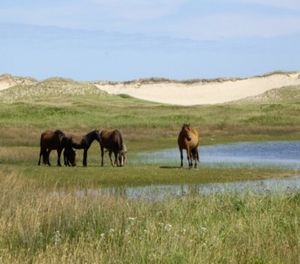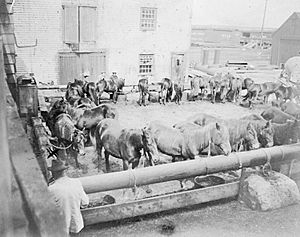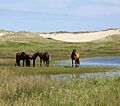Sable Island horse facts for kids
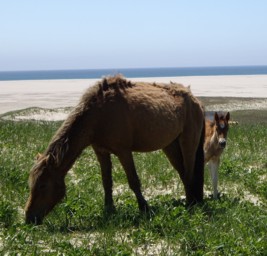
Feral Sable Island horses
|
|
| Distinguishing features | Small, stocky feral horses |
|---|---|
| Country of origin | Sable Island, Canada |
| Horse (Equus ferus caballus) | |
The Sable Island horse (French: Cheval Île de Sable) is a special type of small, wild horse. These horses live on Sable Island, a unique island off the coast of Nova Scotia, Canada. They are often pony-sized but have the look of a horse and come from horse ancestors. Most of them are dark in color.
The first horses arrived on the island in the late 1700s and quickly became wild. More horses were brought later to improve the herd. For many years, people would round them up to sell them, sometimes for meat. By the 1950s, this practice put the horses in danger of disappearing forever.
In 1960, the Canadian government stepped in to protect these wild horses by law. Since the 1980s, scientists have studied the herd carefully without disturbing them. In 2007, a genetic study showed that these horses are very unique, which is important for conservation. In 2008, they became the official horse of Nova Scotia. Then, in 2011, Sable Island itself became the Sable Island National Park Reserve. The horses live freely, and humans are not allowed to interfere with them. Until 2019, a small group of these horses also lived at the Shubenacadie Wildlife Park on the mainland, descended from horses moved from the island in the 1950s.
Contents
What Makes Sable Island Horses Unique?
The horses on Sable Island are completely wild, meaning they live without human care. They usually stand about 13 to 14 hands tall (which is about 132 to 142 cm). Male horses on the island weigh around 360 kg (about 790 lbs), and females weigh about 300 kg (about 660 lbs). The amount of food available on the island affects their size. If horses are moved from the island and given more food, they often grow larger.
Physically, these horses look a bit like Iberian horses. They have arched necks and sloped backsides. Overall, they are strong and short, with short lower legs that help them move easily on sandy or rough ground. Sable Island horses grow very shaggy coats, manes, and tails, especially in winter. Their tails are full and set low.
Most of their coats are dark colors, but some have white markings. About half of them are bay (brown body with black mane and tail). The rest are chestnut (reddish-brown), palomino (golden with a white mane and tail), or black. Many Sable Island horses have a natural ambling gait, which is a smooth, four-beat walk. Before they were protected, when people could use them, these horses were known for being very sure-footed and having smooth gaits.
The Sable Island horse population is completely wild and not managed by people. Scientists have studied them for many years by simply observing them. In recent years (from 2009 onwards), the number of horses has been between 400 and 550. Because there are no predators on the island, older horses often die when their teeth wear down from eating tough grass and sand. This makes it hard for them to chew their food.
History of Sable Island Horses
Sable Island is a long, curved island about 300 km (186 miles) southeast of Nova Scotia. It is 42 km (26 miles) long and covered in sand dunes and grasses. Over 350 types of birds and 190 types of plants live on the island, along with the famous wild horses.
Some old stories say that Sable Island horses swam ashore from shipwrecks, or that Portuguese explorers brought them in the 1500s. However, history and genetic tests do not support these stories. The horses were actually brought to the island on purpose in the 1700s. The first horses on record were brought by a clergyman named Andrew Le Mercier in 1737, but most were stolen by sailors.
Today's horses are mostly thought to be descendants of horses taken by the British from the Acadians. The Acadian horses came from French horses, including Breton, Andalusian, and Norman breeds. These were later mixed with horses from New England, including Spanish Barbs. In 1760, a merchant named Thomas Hancock bought some Acadian horses and sent them to Sable Island to graze. Even though they are small and often called ponies, they are truly horses by their looks and ancestry.
After a lifesaving station was built on Sable Island in 1801, workers trained some horses to carry supplies and rescue gear. Records show a male horse named Jolly was brought there in 1801. He was likely similar to the first Acadian horses. Jolly was not the first horse, but he was the first to be named in records and lived on the island until at least 1812. Other horses, including Thoroughbred, Morgan, and Clydesdale types, were sent to the island in the early 1800s. People hoped these new horses would improve the herd and make them more valuable to sell on the mainland.
During the 1800s and early 1900s, the horses on Sable Island were regularly rounded up. Some were kept by islanders, and others were sent to the mainland to be sold. Many were sold for meat, mostly for dog food by the late 1950s. This put the island horses in great danger. School children started a public campaign to save them. In 1960, the Canadian government passed a law protecting the horses. This law means people need written permission to "molest, interfere with, feed or otherwise have anything to do with the ponies on the Island."
Studying and Protecting the Horses
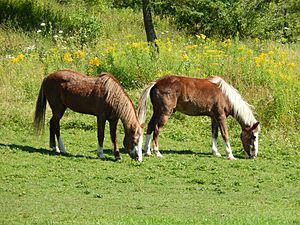
Starting in the mid-1980s, long-term studies of the Sable Island herds began. By the mid-2000s, most horses on the island had their histories recorded. In 2007, scientists did a genetic study of the herd. They found that these horses are genetically similar to other horse breeds in eastern Canada. However, the study also said that Sable Island horses are unique enough to need special attention for their protection. Losing them would harm the genetic variety of Canadian horses more than losing any other breed.
A study in 2012 looked at the DNA of 24 horse populations. It found that the Sable Island horse had the least genetic variety. This means they are more vulnerable to problems from having a small gene pool. A 2014 study by Parks Canada also warned that the horses were at risk from their small numbers, too much inbreeding, and extreme weather due to global warming.
In 2008, the Nova Scotia Legislature made the Sable Island Horse one of the province's official symbols. In 2011, the Canadian government created the Sable Island National Park Reserve. This park helps protect both the island and its horses even more.
Besides the island, Sable Island Horses lived only at the Shubenacadie Wildlife Park in Shubenacadie, Nova Scotia until 2019. This park cared for descendants of horses moved from the island in the 1950s. The last horse there was put to sleep in September 2019. Still, some people think the horses are an invasive species, meaning they don't naturally belong there. They believe the horses should not be in a protected area where the natural environment should be kept untouched.
A study in 2019 found that Sable Island horses had about three times more parasite eggs in their droppings than domesticated horses. This included a parasite that caused breathing problems. The horses also suffered from reproductive diseases. Scientists examined dead horses in 2017 and 2018. They found that young horses often died from not enough food and extreme cold, especially in harsh winters. This is because they didn't have enough body fat, and food is scarce on the island in winter. Adult horses died from other causes. These findings matched a similar study from 1972. The study also found that these horses eat a lot of sand by accident. This sand slowly wears down their teeth and can block their digestive system. In the 2018 study, the estimated population was 500 horses, which was more than the roughly 300 horses recorded in the 1970s.
Normally, about 1% of the horses die each year. However, during a very tough spring in 2017, the death rate was 10%.
Images for kids


